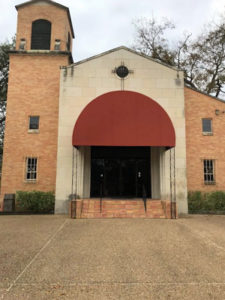I had the good fortune to visit Austin, Texas, at the end of November. The parish of St. Julia is on Lyons Road in Austin.

St. Julia’s, exterior view.
It is mainly an Hispanic parish, and the pastor, Fr. Bradford, is from San Louis Potisi in Mexico. He has an excellent proficiency in both English and Spanish. He treated me graciously, and couldn’t do enough to make my time there as pleasant as possible. There was another resident priest, Fr. Melisio, equally generous, in the parish, and he helped me get settled in since we shared the same premises.

St. Julia’s, interior view.
But, there was one parishioner, in particular, who really fascinated me. David is a ‘general factotum’ around St Julia. Whenever I had a question or needed some help, people just said: “talk to David.” He was not hard to find for he was everywhere. In the hall helping out with Sunday breakfast; in the sanctuary with his sweet, little daughter in tow, preparing the altar for mass; in the Church foyer helping the ushers; in the sacristy assisting the altar servers. David was the man! And, he had impeccable manners, combining a humble attitude with generosity of service. I asked David, “ how did you get into this?” He replied, matter of factly, “I had an attention deficit condition called, ADHD. Nobody wanted to get out of bed to serve the early mass on Sunday morning, so my parents volunteered me, and dropped me off at Church and left me there for the rest of the day. Since I was always there and needed something to occupy myself, jobs kept flowing my way. I’ve been doing this most of my life.” It’s marvelous the way God works. “His Power is perfected in weakness,” St. Paul says. David turned his weakness into a blessing, and St. Julia parish is the grateful beneficiary.

Austin, Texas, on the Colorado River.
The two main masses were in Spanish and the Church was full at both these masses. There were also two masses in English for about seventy parishioners in total. I celebrated all these masses, and had ample opportunity to meet and mingle with all the parishioners who were beautifully open and receptive to my visit. Usually, the parishes I visit have token Spanish masses, but St. Julia was different. It has the major masses in Spanish and it has two token masses in English. So far, I’m told, for this is about to change. The area is becoming gentrified, and Hispanic parishioners are selling their properties for large sums of money and are moving elsewhere while more up-scale, English-speaking people are moving into the parish. This is a trend all over Austin. Everybody was aware of this trend, and seemed to be taking it all in their stride without complaint or anxiety.
I really enjoyed the weekend with the parishioners of St. Julia. The parish was bustling with activities all weekend: Quinceaneras, weddings, fundraisers in the hall, good people doing what they could to help the needy and, of course, weekend masses on Saturday and Sunday.
I wanted to see the famous Alamo in San Antonio while I was in Austin. A lady I met previously on my travels, Margaret Morin, offered to drive me there on the Monday after my weekend masses. It was a unique experience. The Alamo is a World Heritage Site like the Great Wall of China or the Pyramid of Giza.

Alamo Monument to the Fallen.
I learned a few things. The Alamo, originally a Mexican Mission, has no roof over the main structure. That surprised me since I visualized it as a church in the Western style. There is a baptistry, a sacristy, and a chapel to the sides of the main structure. These side buildings are roofed and were used as places of worship at the original mission. The iconic, dome- shaped art work over the entrance which has inspired architects over the centuries is not original. It was added later. The Church in Okeechobee which was built when I was Pastor reminded many people, they told me, of the Alamo with its imposing dome-shaped entrance. I was really looking forward to seeing this for myself. Some might argue it’s a pity it wasn’t part of the original structure of the Alamo. But does it really matter? It is what it is!
It was the Mexicans who invited the Colonists to populate and work the land of Texas as part of Mexico before Texas became a Republic.

Man demonstrating period rifles at the Alamo.
I had been to Washington, Texas, the old capital before Austin, on an earlier trip and visited Constitution Hall where Texas’s Independence was declared. The history lessons were similar in both historic places, but the history of Washington, I found, was augmented and complimented by the history of the Alamo. Washington, Texas, is now a State Park with a population of only eleven people. Its history is not known to many, unfortunately. It lost its position as Capital because it would not permit a railway to run through, placing its prospects on the Brazos River which delivered cotton to the area. The small hamlet of Waterloo, now Austin, displayed greater foresight and accepted the railway and finally succeeded Washington as the Texas Capital. On small things, great issues hang. That surely applies to the little hamlet of Waterloo that grew from insignificance, as a small village, to become the Capital of the second most populated State in America.
I’m back home now, glad to embrace this Florida autumn weather. Texas was cold when I was there, and I had to wear winter clothes. Florida is different. I’m so used to it now that I don’t think I could live anywhere else.
I hope you have a meaningful and good Advent as we prepare for Christ’s birthday. No matter how busy you are, try to enjoy the moment and don’t forget to spread the real joy which Christ gives us so “your joy will be full.” And, smile. It is your greatest social asset and it costs nothing.
Fr. Hugh Duffy











4 Comments
Rosa
I am from Sta. Julia Church, Thank you for your words and your visit Father Duffy.
Hugh Duffy
Oh, my! Glad to hear from you so soon after the Travelogue appeared, Rosa. Let the parishioners know what’s being said about them. What nice people. A joy to be with you.
Johnny O. Limon
Hi Father Duffy. I’m Johnny Limon, the parishioner who gave you a ride back to the Airport. First, Thank You for coming to St. Julia Church. Second, let me Thank You for the wonderful Sermon!
Hugh Duffy
Johnny: There’s no way I could ever forget you. I was very taken by what you told me when driving me back to the Airport from St. Julia. Working on and providing low income housing for those in need in your area, like you do, is a great ministry. I was thinking of you when I made reference in my blog to the good people in St. Julia who were helping out the needy. Thanks also for your kind words.